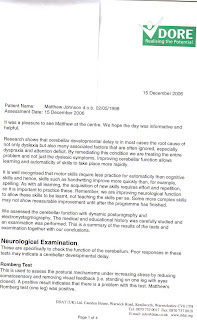Here's an explanation of the assessment results, this is how I see it. Cardiff said they only measure 1, 2 4 and 5 parameters these days as 3 and 6 was making people sick.
1 = Eyes Open (Visual, somatosensory and Vestibular altogether)
2 = Eyes Closed (Somatosensory and Vestibular)
3 = Eyes Open + Screen Moves (this confuses the eyes) Not done
4 = Eyes Open + Platform moves (this makes the feet unstable) (visual and vestibular - somtosensory removed by moving floor)
5 = Eyes Closed + Platform Moves (vestibular only as visual and somatosensory removed)
6 = Eyes Open + Platform and Screen Moves. Not done
From this the sensory data is calculated (by some equation) to give the readings of each of the 3 balance senses separately and compositely. Matthew vestibular balance for the first visit was zero as he shows -1 on the equilibrium score this is in fact 19 this time.The red bars indicates not within normal ranges, as they move out of the pink the red bar will turn green indicateing normal. I think Dore likes to see these normals really high before finishing treatment or at least 3 test within normal(not quite sure about that).Hope that makes sense.
This is the journey of Matthew, 12 years old who has dyslexia and attempts to get a proper education through the UK school system. In our attempt to help him included treatment at the Dore Centre.
Sunday, 17 December 2006
Saturday, 16 December 2006
Friday, 15 December 2006
Our First Dore Assessment

We had our first assessment today 8am. We arrived early and met the manager there. We did the posturography test first.
4 + 5.) Test 4 was eyes open, platform moving, and the final one was eyes shut, platform moving, thats the one with no score.
The sensory analysis results are calculated values for the 3 balance senses and a composite value, as each test on posturograph is a mixture of the 2/3 balance senses.

Smooth Persuit (Eye Tracking) - Significant Difficulty was found
Saccades (Random Eye Movements) - Outside normal limits
Matthew's raw score for the Dyslexia Screening test was 2.89 on a scale of 0-3.0.
0-1, no/low risk
1-2, moderate risk
2-3, significant risk
Posturography Test
1 + 2.) The first 2 were standing still 1 with eyes open, then with eyes shut. The platform under foot was not moving.4 + 5.) Test 4 was eyes open, platform moving, and the final one was eyes shut, platform moving, thats the one with no score.
The sensory analysis results are calculated values for the 3 balance senses and a composite value, as each test on posturograph is a mixture of the 2/3 balance senses.
Oculomotor Test
This was done in a dark room, electrode pads were placed on Matthew's forehead, and he was linked to the computer. A red light them moved smoothly, and also jumped around. Matthew had to follow them best he could. Smooth Persuit (Eye Tracking) - Significant Difficulty was found
Saccades (Random Eye Movements) - Outside normal limits
Dyslexia Screening Test
Following these tests a Dyslexia Screening Test was undertaken. I was not present for this, Matthew was also asked at this point what he would like to improve.Matthew's raw score for the Dyslexia Screening test was 2.89 on a scale of 0-3.0.
0-1, no/low risk
1-2, moderate risk
2-3, significant risk
On the report it just stated that Matthew had a risk factor of >1.0 and was at significant risk (age adjusted score).
The things that Matthew wanted to improve were
- Copying off the whiteboard
- Listening skills
- Writing
After this we saw the Doctor who tests for primitive reflexes and talks you through the test results. She then recommended that should have the therapy as they could help Matthew because he had very definite signs of Cerebellar Development Disorder. (I agree)
Labels:dore,dyslexia, adhd, dyspraxia, add
Dore Dyslexia ADD Dyspraxia assessment
Friday, 1 December 2006
Toe by Toe again
After hearing that Matthew has to start Language Support Lessons again, I pick up Toe by Toe once again. Together with a lovely little online free Reading Tutor called Starfall.com. we move forward. The Language support teacher has measured his reading as -24months at this stage I am now panicking.
Subscribe to:
Posts (Atom)



